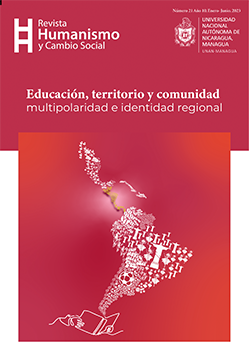Comparative study of years of schooling in Nicaragua, 2009 and 2014
DOI:
https://doi.org/10.5377/hcs.v21i21.16761Keywords:
Schooling, standard of living, poverty, survey, societyAbstract
The main objective of this study is to estimate the years of schooling in the Nicaraguan population between 2009 and 2014, under a comparative approach. The scope of the research is associative, where open data from two Living Standards Measurement Surveys (EMNV) 2009 and 2014 have been used. Sampling was conducted in two stages, in the case of both surveys, inferences were made using a sample of 7,520 housing units, applying two forms, price and household. The variables on which the indicator was constructed were: level of study (S4P12A) and grade or year passed (S4P12B). The results showed that the Nicaraguan population is mostly young and concentrated in the macro region of Managua, with a high percentage of women. Likewise, a higher concentration of people between 6, 11 and 16 years of schooling (primary, secondary and university, respectively) was found. For 2014, compared to the EMNV-2009, a higher average years of schooling was observed in the Managua macro region. It was determined that there is a dependence of the years of schooling and the incidence of poverty, which is evidence that poverty is reduced when a person completes secondary education.
Downloads
244
References
R Core Team (2022). A Language and Environment for Statistical Computing, R Foundation for Statistical Computing [Archivo de datos]. https://www.R-project.org/
RStudio Team (2022). RStudio: Integrated Development for R. RStudio, PBC, Boston, MA
Robles Soto, A. (2000). Sistema de indicadores para el seguimiento y la evaluación de las metas del programa de acción de la Conferencia Internacional sobre la Población y el Desarrollo para los Países de América Latina y el Caribe. Cepal, repositorio digital.
Saad P., Miller T., Martínez C. y Holz M. (2012). Juventud y Bono Demográfi co en Iberoamérica (2ª ed.). Comisión Económica Para América Latina y El Caribe. https://repositorio.cepal.org/bitstream/handle/11362/1495/S2012103_es.pdf
Sistema de Información de Tendencias Educativas en América Latina. (2019). Perfi l de País Nicaragua 2019. https://shorturl.at/iwKMQ
UNESCO (2010). Datos mundiales de educación. Nicaragua 2010. https://www.ibe.unesco.org/fileadmin/user_upload/Publications/WDE/2010/pdfversions/ Nicaragua.pdf
Wickham H. (2016). Elegant Graphics for Data Analysis. (3a ed.). Springer-Verlag. https://ggplot2.tidyverse.org/
Downloads
Published
How to Cite
Issue
Section
License
Copyright (c) 2023 Universidad Nacional Autónoma de Nicaragua, UNAN-Managua

This work is licensed under a Creative Commons Attribution-NonCommercial-ShareAlike 4.0 International License.




